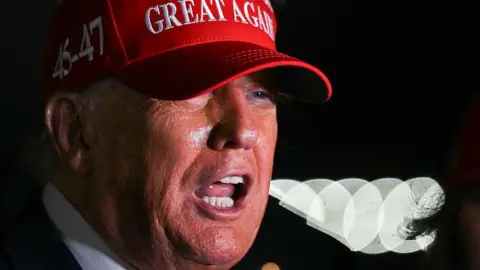Trump says US to start sending out tariff letters
 Getty Images
Getty ImagesThe US government is to start sending out letters to countries with details of higher US tariff rates that will begin on 1 August, President Donald Trump has said.
Between 10 to 12 letters will go out on Friday, with more over the coming days, the president told reporters.
The import duties will range from "60% or 70% tariffs to 10 to 20% tariffs," he said, the top end of which is higher than he had previously outlined.
Trump has set a deadline of 9 July for negotiations over import tax rates as countries scramble to reach deals.
He has previously said there would be a baseline tariff of 10% on many economies up to a 50% maximum.
Trump did not say which countries' goods would face the US taxes, or whether the rates would only apply to certain goods.
"My inclination is to send a letter out and say what tariff they're going to be paying," he told reporters on Thursday. "It's just much easier."
He added: "We're going to be sending some letters out, starting probably tomorrow."
Tariffs are taxes imposed on goods coming into a country, paid by the importer.
Those firms may choose to swallow the higher costs, but ultimately are likely to pass them on to US consumers.
The idea is to have more money flowing into the US government, and also to make foreign goods more expensive, so boosting demand for US-made goods.
Trump's comments come before a deadline next week that could see steeper duties imposed on goods from a number of countries.
These range from the European Union, which was previously threatened with 20% tariffs later raised to 50%, to Japan, which could face 35% tariffs on its goods.
The UK and US have partly agreed a trade deal, covering UK cars and US beef and bioethanol, but not steel.
The world's largest economies, China and the US, initially engaged in a tit-for-tat trade war that imposed massive "reciprocal" tariff increases in April.
The US imposed 145% tariffs on Chinese imports, while China put 125% tariffs on some goods.
After negotiations the countries agreed to drop the taxes to 30% and 10% respectively while they negotiate. Last month, the two said they had agreed details over matters such as the export of rare earth materials and the easing of tech restrictions.
